Introduction
Front
{{section_header}}{{section.name}}{{/section_header}}
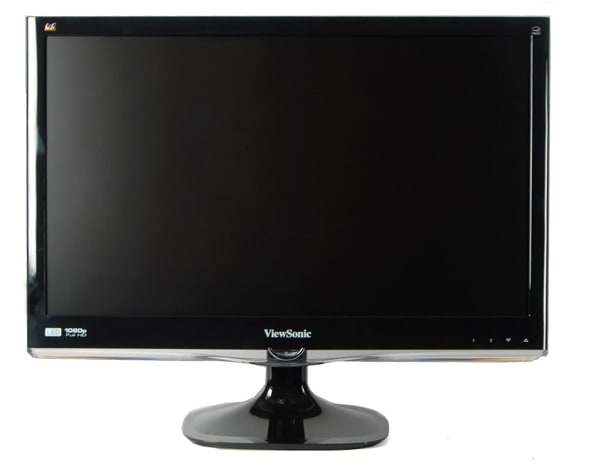
Back
{{section_header}}{{section.name}}{{/section_header}}

Sides
{{section_header}}{{section.name}}{{/section_header}}
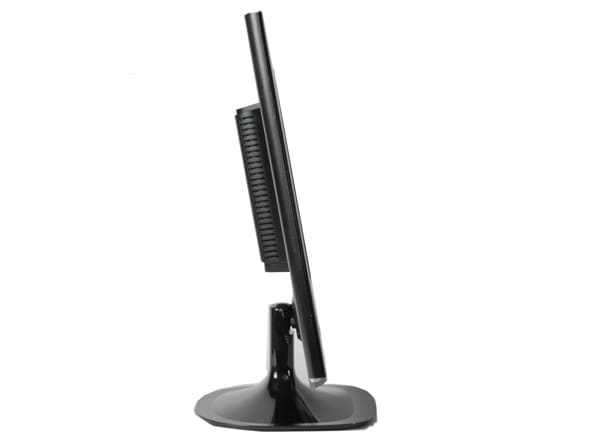
Size Comparisons
{{section_header}}{{section.name}}{{/section_header}}
In the Box
{{section_header}}{{section.name}}{{/section_header}}
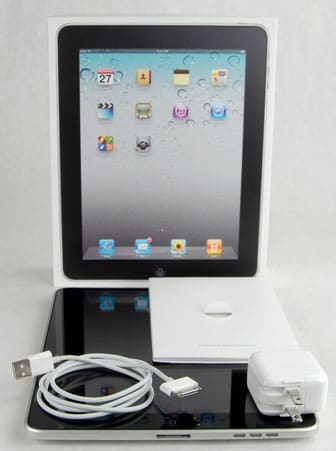
The Samsung Galaxy Tab comes with three non-manual objects in its box: a USB cable, a wall plug adapter for said USB cable, and a cheap pair of headphones.
Handling
{{section_header}}{{section.name}}{{/section_header}}
The Tab isn't a small device. It LCD touchscreen is a big 7 inches and a bit on the heavy side, so it might feel a bit awkward to hold with a single hand. Holding it with two hands is much more comfortable, and the bezels to the sides of the touchscreen provide a good gripping area.
There are a handful of touch controls located just under the screen that offer haptic feedback when tapped. They're a bit of a reach from a natural grip, but they're in no way a pain to access.
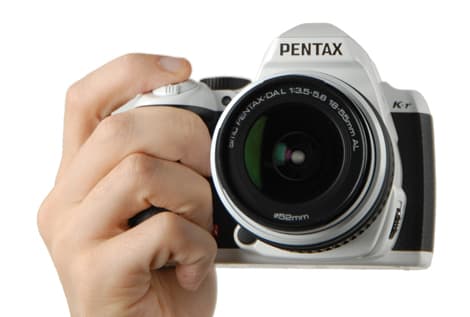
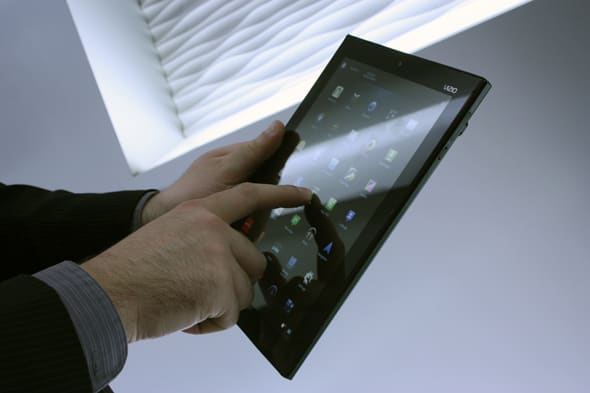
Screen
{{section_header}}{{section.name}}{{/section_header}}
The Galaxy Tab is built around a 7-inch WSVGA LCD screen, with a resolution of 1024 by 600 pixels. This gives you about 21 inches of screen real estate, which is smaller than the iPad by a quite considerable amount. The upside of this is that the device itself is smaller: it would easily fit into a coat pocket or small bag.

Indoor & Outdoor Use
{{section_header}}{{section.name}}{{/section_header}}
The Galaxy Tab uses an LCD screen, which has some distinct pros and cons. On the upside, it generates its own light from a backlight, so you can read it in darkness under the covers. The downside is that this backlight has to compete with the sun outdoors, and that is not a battle that it wins. In anything more than indirect sunlight, the screen of the Galaxy Tab becomes pale and unreadable, unlike the passive eInk displays of devices like the Kindle or the Sony Readers. Below are photos that we shot under a variety of lighting levels to show how the screen looks.
Controls
{{section_header}}{{section.name}}{{/section_header}}
The Galaxy Tab has only a few physical buttons, with a power and volume controls located on one side. There are also a number of touch sensitive buttons at the bottom of the screen. These access (from the left) the menu, the home screen, previous screen and search. All of the other controls on the device are accessed from the touch screen, which we found to be very responsive and easy to use, although it was a little oversensitive, sometimes mistaking accidental brushes for touches.
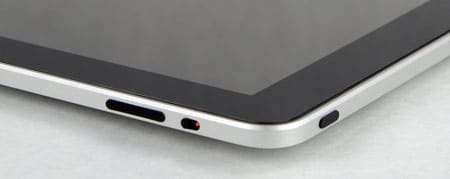
The controls on the top right side of the iPad body: volume, lock and power.
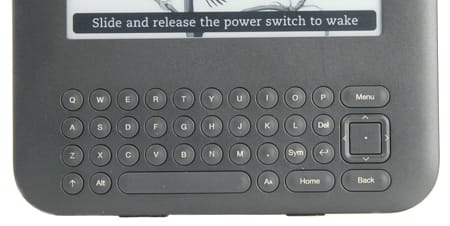
Connectivity
{{section_header}}{{section.name}}{{/section_header}}
The Samsung Tab comes in a number of different versions designed for use with different cell networks. We looked at the T-Mobile version, which offers 3G connection speeds for fast browsing and downloading. It also offers a Bluetooth radio for connecting to devices such as wireless headphones or headsets. This is particularly useful if you want to do a lot of typing and don't like the on-screen keyboard.

Here we see a Lightning dock in its natural habitat.
WiFi is also included, with the device having no issues in our tests connecting to 802.11n wireless networks.
Battery Life
{{section_header}}{{section.name}}{{/section_header}}
Our battery life testing is still underway, but the first result we have is interesting: the Galaxy Tab was able to keep playing a video for an impressive 8 hours and 22 minutes.
Reading Books
{{section_header}}{{section.name}}{{/section_header}}
If you're done playing around with the tens of thousands of Android apps and ready to settle down with a good eBook, download the Aldiko app. Or the Barnes & Noble NOOK app. Or the Kobo App. Or the Kindle app. Really, since the Galaxy Tab runs Android, you can download apps for just about every eBook store out there.
Most of these apps function like the Apple iPad's iBook app: each one is a portal to eBooks purchased with that specific app. The downside to this is there's no way to merge content amongst multiple apps. If you found a book that's only available through the Amazon Kindle app, you can't read it in another program. But eBooks and the reader programs are small, so you won't run out of space, as the Galaxy Tab offers 16GB of internal storage.
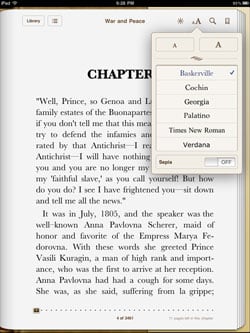
The iBooks program offers a range of controls for font and text size
Browsing around an eBook is done with horizontal swipes along the touchscreen. These feel similar to turning the page of a paper book: swipe left to proceed to the next page, swipe right to return to the previous one.
You can also access more navigation options by tapping the screen to bring up reader menu. Most of the elements of this menu are aimed at aiding navigation. The top right of the screen has a search feature, which lets you search the document for a given word or phrase. Toward the bottom of the screen is a scrub bar that lets you navigate through the document—it's similar to how a scrub bar would work on a video or music file, only you're skipping between pages and not time stamps. The "Go to..." button lets you access the table of contents, go to your bookmarks, add bookmark, or jump to a specific page.
Buying Books
{{section_header}}{{section.name}}{{/section_header}}
Since the Tab runs Android, there are quite a few book stores available. We were going to use Google books (it seems like a natural fit) for our explanatory walkthrough, but almost every link in the app was broken when we tried it, we'll use Aldiko instead.
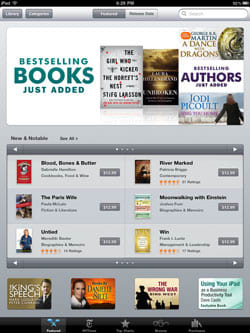
Books can be purchased on the iPad through the iTunes store
The Aldiko store is an amalgamation of different stores. At the moment you can purchase (or download free) content from Feedbooks.com store, O'Reilly's eBooks, and Smashwords. Once you've booted up the program, just click the shopping cart and these three services will start showing you their wares. The top of the screen should have a little carousel of bestsellers' thumbnails, underneath which are a few different categories. Chances are, though, your best bet is with the little magnifying glass in the top right corner: searching is definitely the fastest way to find the book you want.
Then, once you've tracked down your eBook query and decided it's worth whatever price is listed, just click on either the cover or the little green price rectangle and you'll be taken to a longer description of the piece. From here you just click that inviting green price box again, fill out your info, and that shiny new eBook is all yours.
eBook Formats
{{section_header}}{{section.name}}{{/section_header}}
{{product.manufacturer_specs['eBook Formats Image']}}
The Samsung Galaxy Tab basically supports any given eBook format: it just requires you to use the right app. If the book you really want is an Amazon exclusive and only available in the .AZW format, you can just download the Kindle app.
Of course, each file is linked to the app that you've purchased it with, which could get confusing if DRM ends up ruling the eBook space. Having dozens of different apps each with their own proprietary content might make finding the eBook you're looking for a bit difficult.
Newspapers & Magazines
{{section_header}}{{section.name}}{{/section_header}}
Much like the iPad, the Samsung Galaxy Tab uses apps in lieu of a true subscription service. Most of these apps are free to download from the Android marketplace.
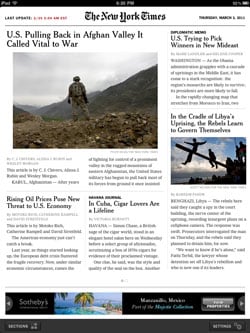
The New York Times is available on the iPad through their own app
eBook Battery Life
{{section_header}}{{section.name}}{{/section_header}}
{{product.manufacturer_specs['eBook Battery Life Image']}}
Music & Audio Controls
{{section_header}}{{section.name}}{{/section_header}}
The Galaxy Tab runs Google's Android OS version 2.2 (AKA Froyo), and includes a basic, but very usable music player. This player shows the information on the track (including the cover) and presents the controls at the bottom of the screen.
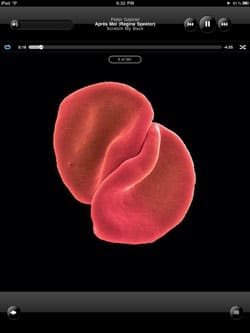
The iPod app shows the cover art while playing music
bTunes for those who want an iPod-like experience.
Music & Audio Management
{{section_header}}{{section.name}}{{/section_header}}
The Galaxy tab music player does a decent job of organizing music: it defaults to a list of all of the songs on the device, but this can be set to instead show a list of playlists, albums, artists or genres. You can also search for a particular song or artist with a text search.
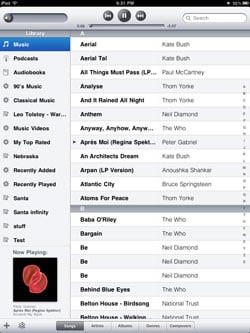
Audio files can be sorted by title, artist, album, genre or composer
Music & Audio Formats
Music & Audio Battery Life
Video Controls
{{section_header}}{{section.name}}{{/section_header}}
Much like the audio features, the built-in video player on the Samsung Tab is rather basic, but is adequate for general use. It offers basic controls that allow you to fast forward and rewind a video, as well as skipping to a particular point using a scrub control. You can also alter volume, screen brightness and place bookmarks in videos to come back to later.

Video Management
{{section_header}}{{section.name}}{{/section_header}}
The video player takes a similar approach to managing videos as the audio player, dividing videos up into recorded, downloaded and the folders that they are stored in. There is also a thumbnail search (called Mosiac search) that presents all the videos as small playable thumbnails, which is useful if you are looking for a video, but can't remember the name.
The Galaxy Tab has 16GB of onboard memory, but this can be extended by plugging in a Micro SD memory card, and cards with capacities of up to 32GB are supported.
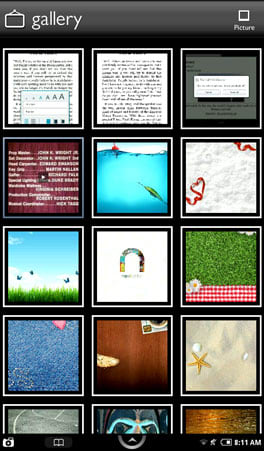
The gallery is used to navigate videos, and only offers thumbnails
Video Formats
Internet Video
{{section_header}}{{section.name}}{{/section_header}}
UStream allow you to use this camera to broadcast live over the Internet.

Video Battery Life
{{section_header}}{{section.name}}{{/section_header}}
Both email and web support are baked right into the Android OS, so it is no surprise that the Galaxy Tab offers excellent email features. There are several email programs built into the device, including one written by Samsung and the Android Gmail client. Both of these are good, but the Gmail client is the better one, with more integration into Google's own mail service. Support is also offered for communicating with a range of other mail servers and services, including POP3, IMAP and Microsoft Exchange support.
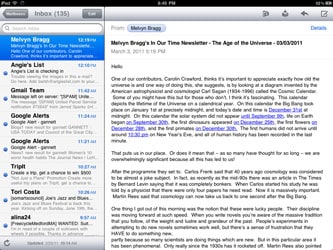
The iPad email app is basic, but adequate for most users
Web Browsing
{{section_header}}{{section.name}}{{/section_header}}
The web browser that is built into the Samsung Tab provides a good range of features, including bookmarking, JavaScript support and multiple windows. It also supports Flash, so you can browse web sites that use flash content.
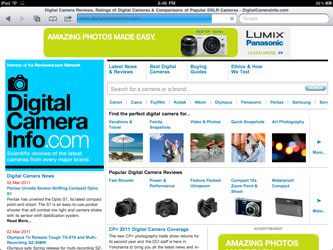
The iPad boasts a fully featured Safari web browser
Internet Apps
{{section_header}}{{section.name}}{{/section_header}}
The Android operating system includes access to the Android Market, which offers a huge selection of programs that can be downloaded to use, including both paid for and free programs. A good selection of programs are on offer, ranging from games to utilities and professional programs. The number of programs available is not as big as the Apple App Store for the iPad, but it is wider: Google has fewer limitations on the programs that are available, so you can find programs in the market that replace the built-in functions of Android devices.

However, this lack of limitations sometimes means that the programs on offer are not particularly good, and there have been incidents of programs being available that were thought to contain spyware that might have tried to transmit the details of users to someone online.
Other Internet Features
{{section_header}}{{section.name}}{{/section_header}}
{{product.manufacturer_specs['Other Internet Features Image']}}
Device & Specs
{{section_header}}{{section.name}}{{/section_header}}
The Samsung Galaxy Tab and the Apple iPad are remarkably similar. They both feature similar aesthetics, both in terms of physical design and software. Both units have high resolution color LCD touchscreens. Neither device is intended for use as a dedicated eBook reader, but both can perform the function well. One salient difference between the two is their price: the Tab costs about $250 wile the iPod retails for $400, despite the fact it'll be obsolete in a few days.* Both devices use a color LCD touchscreen.
* Both devices are very extensible.
* The Samsung Galaxy Tab costs about $250; the Apple iPad costs about $400.
Screen
{{section_header}}{{section.name}}{{/section_header}}
Both devices have a very similar screen: both are color LCD touchscreens with a fairly high resolution and good color performance. The Tab's display is two inches smaller along the diagonal, however, which gives the iPad a lot more screen real estate to work with.
Battery
{{section_header}}{{section.name}}{{/section_header}}
eReader
{{section_header}}{{section.name}}{{/section_header}}
If you're just looking for an eBook experience, the Tab might be the better choice because you can download many different eBook retailer apps; with the iPad you're stuck with the iBooks app, which has a somewhat lackluster selection.
Internet
{{section_header}}{{section.name}}{{/section_header}}
While the Apple App Store certainly has many, many more options available for download compared to the Android Market, Google isn't limiting the available content as much as Apple is. If you're really into modding your device, the Tab might be the better pick; if you're looking for the largest library of apps to pick from, then the iPad is for you.
Device & Specs
{{section_header}}{{section.name}}{{/section_header}}
This is the age-old battle of LCD vs. eInk. The Samsung Galaxy Tab features an LCD display and the :Amazon Kindle":https://reviewed.usatoday.com/tablets/content/Amazon-Kindle-Review.htm has an eInk screen. The Kindle is more of a straight-up eReader and is heavily subsidized from Amazon.com: the Wifi and 3G-enabled device only costs $180, while the Tab costs about $250. In terms of use, both products are very different. The Tab, like the iPad, is more of a general purpose device: you download the apps you're interested in, and if one of those apps lets you buy eBooks, so much the better. The Kindle, on the other hand, is a dedicated eBook reading device.
Screen
{{section_header}}{{section.name}}{{/section_header}}
The Kindle's eInk display creates an experience that's very similar to reading print. The Tab, on the other hand, relies on an LCD. Whiel the LCD will let you read in pitch-black environments, typically the Tab will do better in brighter scenarios.
Battery
{{section_header}}{{section.name}}{{/section_header}}
eReader
{{section_header}}{{section.name}}{{/section_header}}
Android is a very open platform and lets you download many eBook apps, including one for the Amazon's eBook store. The Kindle, on the other hand, exists in a walled garden where non-Amazon eBooks exist merely in legend.
Internet
{{section_header}}{{section.name}}{{/section_header}}
The Kindle has some online features, such as a full browser, the ability to download eBooks over 3G, and a few apps. The Tab, on the other hand, has Android behind it, which is an established platform for mobile programs. This isn't much of a contest: the Tab has far, far better internet features than the Kindle.
Device & Specs
{{section_header}}{{section.name}}{{/section_header}}
The Barnes & Noble NOOKcolor has a color LCD touchscreen instead of its predecessor's eInk display. While this makes the Samsung Galaxy Tab easier to compare, it also means anyone who's interested in an eInk screen can skip this page of the review.
If you're still here, this match-up seems pretty cut and dry: the Samsung Galaxy Tab does just about everything the NOOKcolor does, only better, with far greater extensibility, and at the same price.
Screen
{{section_header}}{{section.name}}{{/section_header}}
Both tablets feature 7-inch color LCD touchscreens that scored well on our picture quality tests. There's really not a huge gulf of difference between the two.
Battery
{{section_header}}{{section.name}}{{/section_header}}
eReader
{{section_header}}{{section.name}}{{/section_header}}
Both devices have very similar performance as eReaders. To change pages you simply swipe across the screen. Both devices also have advanced navigation features and note-taking options.
Internet
{{section_header}}{{section.name}}{{/section_header}}
The internet features area is really where the two devices separate. As an Android device, the Samsung Galaxy Tab supports over 30,000 apps. The NOOKcolor currently only has a handful of apps at its disposal. Aside from this one huge discrepancy between the two devices, the rest of the online feature set is largely the same, with both offering a decent web browser.
Conclusion
Performance
We were impressed with the Galaxy Tab: it offers a lot of power in a fairly small package. But it is not as sleek or elegant as the iPad, and it lacks the big screen and usability polish that makes the iPad such a favorite.
NOTE: this is an in-progress review, so please check back regularly for updates and our final conclusions. We do not assign final scores to products until all of our tests are complete, and our battery testing is still ongoing.
Screen Performance
The screen of the Galaxy Tab is a mixed bag: it is clear, sharp and easy on the eye, but it is also very shiny and shows reflections. It also suffers in bright sunlight, becoming very pale when the sun comes out and pretty much unreadable in direct sun.
Battery Life
Our battery tests are ongoing: we will update this review as the results come in.
Ereader:
The Galaxy Tab excels as an eReader because it provides access to a huge range of online bookstores: Amazon, Barnes & Noble, Kobo and many more. However, some of the problems we mentioned above limit the usability of the device, and it would be a poor pick for reading by the pool or on a beach.
Audio & Video:
The Galaxy Tab excels as an audio and video player, providing a good selection of features for both and the ability to use other programs if required. Videos look great on the screen, except when you are sitting in a sunny spot.
Email & Web Browsing:
The Android operating system has email and web browsing built in, so it is no surprise that the Galaxy Tab excels at both.
Meet the tester
Richard Baguley is a veteran writer who has written about technology ranging from Alphabet to Zip file utilities. He has contributed to pretty much every major tech publication, including Amiga Format Magazine, PC World, Wired, CNET, Toms Guide, Forbes, and many others. He lives in the Boston metro area with his wife, dog, and an indeterminate number of cats.
Checking our work.
Our team is here for one purpose: to help you buy the best stuff and love what you own. Our writers, editors, and lab technicians obsess over the products we cover to make sure you're confident and satisfied. Have a different opinion about something we recommend? Email us and we'll compare notes.
Shoot us an email
